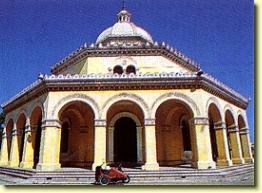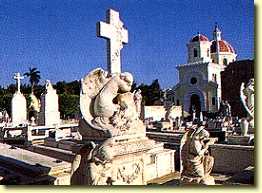|
|
|
|
by Bernd Kubisch,dpa |
|
|
Pantheon Authority by: DuMont visuell |
Havana - The Necropolis Cristóbal Colón in Cuba is one of the most magnificent and unusual cemeteries in the world. Combining the functions of an open air museum, memorial and place of burial, it also attracts Cuban pilgrims and an increasing number of foreigners.The necropolis reflects Cuba's contradictory history. Sugar barons, dukes, poets and Spanish colonial aristocrats rub shoulders with Cuban freedom fighters, revolutionaries and explorers. According to Eusebio Leal Spengler, writing in the cemetery guide, more than 50,000 family tombs, mausoleums, galleries and chapels go to make up what is both a museum and a Cuban national monument. |
|
The routine is the same as all over the socialist island - foreign visitors pay an entrance fee in dollars for the privilege of walking the paths and broad avenues which criss- cross the cemetery. American Chevrolet and Cadillac "gas-guzzlers" from the 1950s are a regular sight, chugging through a forest of marble and granite statues of the Madonna and Jesus on the cross, past obelisks and temples, arches and extravagantly decorated mausoleums. Palms and swathes of green alternate with gleaming white examples of neo-baroque, neo-gothic and art deco architecture. The 21-metre- high main entrance gate or portada principal is reminiscent of the Arc de Triomphe in Paris. From there, a crowd of mourners follows a coffin along the Avenida Columbus to the capilla central. The chapel was built in 1886, its stained glass windows imported from Genoa. Inside, the frescoes above the altar are the work of the Cuban artist Miguel Melero.
At the time of its construction in 1871, the Columbus cemetery lay some distance from Havana. The site was chosen to relieve the overcrowded church catacombs in the city. Families of the rich and famous and the patrons of Cuban heroes vied to build the most impressive monuments. Beside them a rare example is the underground Galeria de Tobias which stretches for about 100 metres and boasts some 256 recesses in the rock. Although officially Catholic, the architecture here has been influenced by Protestantism and afro-Cuban religions as well as the traditions of Japanese and Chinese immigrants. . |
|
|
La Milagrosa Authority by: DuMont visuell |
Many people come to worship at the grave of a woman who has assumed the status of a saint. It is the grave of Amelia Goyri de Hoz, who is worshipped as the "milagrosa", or miracle worker. From a wealthy family, she died in childbirth in 1901. Her baby's body was buried at its mothers feet but when the sarcophagus was later reopened, the mother was found holding the baby in her arms, both corpses showing no signs of decay. The milagrosa's widower supposedly returned to the grave every day until his death in 1941. |
| He
is said to have reminded his dead family of his visits with the brass
knocker which adornsthe tomb.Many pilgrim still perform this ritual
today. From the
small chapel housing the remains of the bar owner and inventor of the
daiquiri, Constante Ribalaigua it is not far to the obelisk marking the
last resting place of General Maximo Gomez. He was one of the leaders of
the Cuban independence movement in the war to overthrow Spanish rule
between 1895 and 1898. In a communal grave lie the "martyrs of
Granma", who in 1956 boarded the vessel of the same name to join
Fidel Castro in deposing dictator Fulgencio Batista.
Likewise have been honoured with splendid tombstones: The students, executed in 1871 without ever having confessed to the crime of desecrating the grave of a Spanish journalist. Vehement public protests could not save the eight medical students. The same with the firemen, who lost their lives while battling to control a large blaze in Havana in 1890. They got the mausoleo de los bomberos, or firemen's mausoleum. Diese Geschichte auf Deutsch lesen |
|

